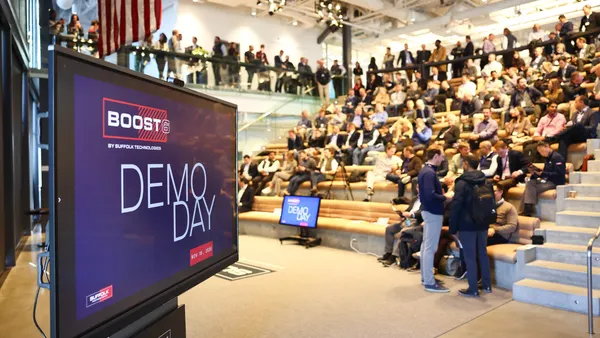The transportation sector — tied closely to the building industry — is facing the same challenge as construction: drawing women into the business and keeping them from leaving. Females represent only 9% of the construction industry and 12% of the transportation industry, but they make up 47% of the total U.S. workforce.
"It’s pretty clear the AEC industry cannot remain predominantly white male," said Blake Peck, president and chief operating officer of consulting firm MBP, during a talk at the Construction Management Association of America National Conference & Trade Show. "An industry cannot complain about labor shortages if it fails to attract talent from a majority of our population."
During the event this week in San Diego, a panel of five women veterans of the transportation and engineering industries spoke to a majority-male crowd and shared their stories, ranging from triumphs to failures. The "Boots On the Ground, Flats in the Boardroom" session takes its name from a book out in September 2015 featuring these and other women who rose to powerful positions in transportation-related departments across the U.S.
Below are three key takeaways from the discussion for companies seeking to improve they way they attract and retain women:
Recognize the benefits of a diverse team, and take action
The panelists emphasized the business and moral benefits of improving diversity in a workplace. "If as an organization you’re struggling, it’s an employment issue," said Grace Crunican, general manager for the San Francisco Bay Area Rapid Transit System. "The better you can be apprised of the room and make every single person feel included, the better your firm will be. I like to say that I've got an orchestra, and I don’t get to play as many tunes if all I’ve got is violins."
The speakers noted that throughout their careers, they've come across countless construction teams unaware of their lack of diversity. "We give out a lot of contracts, we do a lot of work," said Rina Cutler, senior director of major stations, planning and development for Amtrak. "I can’t tell you how many times a team came in to present to me and brought four or five white guys. They weren’t even conscious of it."
Cutler said she and other leaders can use their influence to advise companies to bring in a team that represents a variety of backgrounds and viewpoints. "It will go a long way if your teams are diverse with women and minorities," she said. "I’m going to take that as a really good sign of the goals and culture of your company."
When their careers started out, Culter and the other panelists said the number of women transportation leaders was miniscule. However, they rose to positions of power because men in leadership roles recognized their talent and the benefit they could add to the organization. "There are a lot of women who got here because some white males gave them an opportunity," Crunican told the audience. "Any of you can be that for women."
Don't be afraid of new challenges and risks
While some of the women sought a career in transportation and others ended up there by chance, they all said they wouldn't have achieved success without taking risks in their careers.
Mary Jane O'Meara, associate vice president of HNTB, said that when she received a call asking her to run a toll bridge, she was concerned about making a major career move to a part of the field that she knew little about. However, taking that risk was the "best thing" she could have done, she said.
Cutler told the story of her decision to uproot her life and travel cross country to work in San Francisco. Although that risk didn't pay off initially — as it led to a hostile work environment and the "hardest job" she ever had — it also catalyzed her career and opened countless doors moving forward.
"I don’t think they were used to having a woman at the top of the organization, and they didn’t like that I was from the East Coast," she said. "Everybody knew my job better than I did. But that was really the launching point of my career. So what started as a very risky entry and the worst work experience of my career turned out to be career-making for me."
Cutler advised women professionals to take risks and expect to land on their feet, as it will pay off in the long-run. "Do something you can’t imagine doing," she said. "People have underestimated people like us our entire lives, but they only do it once or twice."
Be a mentor and coach for the next generation
All five industry leaders highlighted the importance of cultivating the younger generation of talent and helping newcomers succeed.
Beverly Scott, CEO of Beverly Scott Associates and former general manager of the Massachusetts Bay Transportation Authority, is a strong advocate for ensuring that younger workers have a chance to make a difference in an organization. "I have really tried to put a lot more into lifting up the next group and helping them get there," she said. "What really makes leaders is the opportunity to have exposure and experience. Think about mentoring, coaching and sponsoring to help proactively make that next group have those experiences and exposure."
O'Meara encourages senior professionals to actively include younger employees so that they are exposed to all aspects of the job. She noted that in too many situations, young people aren't permitted to work with the client. Without that valuable experience, they can't grow and succeed when they take the reins in the future.
Elizabeth Levin, president of management consulting company Liz Levin & Company, said she believes everyone should seek to contribute to their company or agency. Rising in the ranks shouldn't be rooted in solely personal reasons, but because someone "wants to make this organization better," she said.
Cutler added, "Every job I go into, I go into it with the goal of if I leave, I have created more than one person who could step up and take my job."




















